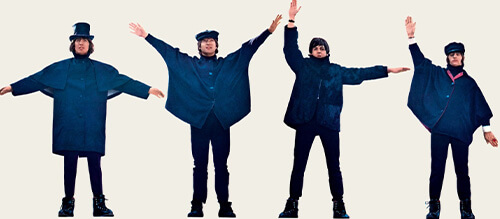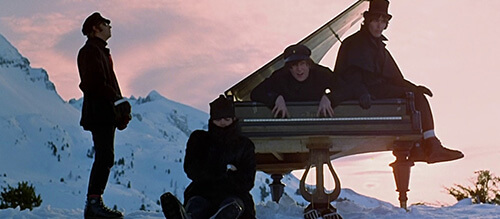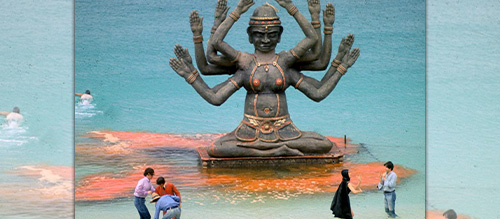Help! (1965) Retrospective Review
Help! (1965)
Director: Richard Lester
Screenplay: Marc Behm, Charles Wood
Starring: John Lennon, Paul McCartney, George Harrison, Ringo Starr, Leo McKern, Eleanor Bron, Victor Spinetti, Roy Kinnear, John Bluthal, Patrick Cargill
When researching the movie Help! (including “the making of”) it becomes clear that there’s a consensus that this, The Beatles’ second film, is the visual equivalent of “Can you smell weed?” Even more cruelly, some critics and film buffs label it as disappointing in comparison to A Hard Day’s Night. As phenomenal as A Hard Day’s Night is as a movie and a tangible piece of history, is that enough justification to ignore its less popular little brother?
During recent years of social, political and economic turbulence, experts from all disciplines have been trying to understand why we are at loggerheads with each other. As time has passed, there has been a creeping realisation that the 60s still holds a sizeable power over our current society. Its wars, changing politics, social politics and its transforming personal values and morality seem to be the forerunners of some of the issues the world faces today. It was the first time in history where these changes were so meticulously documented and then broadcast to the general public – it would have been this mass sharing of information itself that stoked the flames of change, making them so sweeping. The music, film and television of the 1960s still enjoys continued popularity to this day, and none more than the music of The Beatles. With The Beatles’ reputation of being the greatest band of their era, nay of all time, it seems foolish to ignore any of their creative output. So does Help! entertain? Does it provide an insight into our contemporary history? Or, does it deserve to be forgotten?
Richard Lester drew on the strengths of A Hard Day’s Night and simply exaggerated them in Help!. More confident in The Beatles’ acting ability, Behm and Wood’s script provides more than just one-liners for the boys to deliver and a fleshed out story to carry; George Harrison and Ringo Starr were given more focus after being the best actor and the most sympathetic presence respectively in the previous film. Of course, the sarcasm and dry wit of The Beatles remains, providing many laughs, but the surreal element that had only been winked at before is dialled up to eleven to great effect. Combined with a bizarre story, Help! is a gem of British surrealist comedy, reminiscent of the likes of ‘Monty Python’s Flying Circus’ and even the later-released ‘The Mighty Boosh’. But, “bizarre” doesn’t even begin to cover the full extent of the weirdness of this movie.
Audiences were set up to be befuddled in the very first scene in which a human sacrifice is about to be made to the Goddess Kali. Before any blood is spilt, the High Priest’s hand (Leo McKern) is stayed by the realisation that the sacrificial victim is missing their necessary sacrificial ring. It turns out that the savvy lady in question didn’t fancy disembowelment that weekend and popped the ring in the post as fan-mail to The Beatles’ drummer, Ringo Starr. The High Priest (John Bluthal) and Priestess (Eleanor Bron) travel to England to retrieve the ring from the clueless Beatles to finish their ritual. However, after so much time passes, the new intended sacrificial victim becomes poor Ringo. Thus, an absolute mad caper ensues in which the band are chased across the globe by the religious cult, with a mad scientist by the name of Foot (Victor Spinetti) and his oafish assistant Algernon (Roy Kinnear) also in tow.
With the popularity of the more slapstick sequences from A Hard Day’s Night, such as the sports field hi-jinks to “Can’t Buy Me Love” (fans often dub the movie as the Godfather of MTV), it seemed wise to stuff Help! with much more ridiculous mischief. Like in the previous movie, the pace and mood of the picture is driven by the wonderful music of The Beatles, but in Help! these musical interludes are no longer cool and understated, instead becoming an excuse for insanity and tomfoolery to ensue, the most memorable of which is the “Ticket to Ride” sequence based in the Alps. Lester ingeniously edited the honest to goodness footage of The Beatles’ first attempt at skiing – nothing is quite as amusing as watching the boys ungainly slide down the slopes on all fours, arse first. On top of The Beatles’ pop track, the film is also peppered with sections from instantly recognisable classical pieces, such as Beethoven’s “Ode to Joy” and Tchaikovsky’s “1812 Overture”. They serve as a backdrop to unrestrained action sequences, including the Fab Four commandeering a tank to escape heavy artillery.
If A Hard Day’s Night established the individual personas of The Beatles, then Help! transformed them into cartoon characters; something that was achieved remarkably without selling out. Yes, the image of the band in A Hard Day’s Night seems much more organic, but their core personalities (which makes them such an attractive bunch) remain in Help!. Their cartoonish portrayals arise from occupying the fantastical world of the movie, their actions and reactions controlled and determined by the absurd situations they find themselves in. These slightly fictionalised versions of themselves are also incredibly likeable as they exude a Peter Pan quality of never truly growing up. In this respect, The Beatles were able to reach out to a different kind of audience they hadn’t really conquered yet: children. The exaggerated silliness of these larger than life characters (now finally seen in colour) are incredibly appealing to children and prove to be very quotable: ‘It was you buzzing! You naughty boy!’ For subsequent generations, Help! acted as a gateway to the rest of Beatlemania, claiming new lifelong fans who wanted to be as footloose and fancy free as The Fab Four appear to be.
However, some audiences find this action-packed, almost world tour adventure somewhat incoherent; The Beatles do go missing in the chaos on occasion. John, Paul, George and Ringo even admitted themselves that they felt like extras in their own film – well lads, don’t you think hitting the whacky baccy might have contributed a little? (Despite it being reported that The Beatles were stoned out of their minds whilst filming, it isn’t actually that noticeable, I mean it’s nowhere near the same level as the dreadful, made for TV, Magical Mystery Tour.) Ultimately, the movie was supposed to serve as a vehicle for The Beatles’ music, which it does superbly; this is the first time most of their fans would have seen them perform their songs in colour, and it is gorgeous. Each frame of the film has its own unique colour treatment so that the movie has an overall almost kaleidoscopic effect. The harmonies of John, Paul and George whilst performing “You’re Going to Lose That Girl” in a swirl of pink and purple smoky haze is simply beautiful.
Help! is also a showcase of Britain’s mastery of surreal comedy. The fact that some American viewers mistook the very real sport of Curling as another fantastical element of the film is an endless source of amusement to those in the know. Unfortunately, it is on this topic of comedy in which the movie’s greatest problem arises: a large part of the humour of Help! is racist.
Some may brush off this criticism as a none issue, with comments like “it was a different time” etc., but it’s not okay. The main driving force of the plot is an Asian religious cult that is obsessed with human sacrifice and is hell bent on murdering Ringo; this is outrageous, damaging and hurtful. Even worse, the actors portraying the cult are white, British actors (some with Eastern European heritage) who are putting on what are supposed to be a funny foreign accents. An alarming aspect of this created foreignness is that the deity the movie uses, Kali, is not a made up one, but in fact a real Hindu Goddess; it can’t be denied that the use of a real-life worshipped deity in such a fashion is mocking an entire religion. What is particularly stinging is that the racism is of a quintessential British variety, reminiscent of the bigoted, ignorant playgrounds of northern England. Help! seems to serve as a reminder of the reverse-colonialism steeped xenophobia that lies at the heart of British culture, which has never entirely been stamped out.
What’s most upsetting for fans of the group is the fact that The Beatles must have found the script amusing to some degree; at least enough to be okay with being in such a movie. This is a hard pill to swallow as The Fab Four are often used as symbols of the social progression of the 1960s, personifying its idealistic visions of peace and love. In fact, this is evident in their other movies (e.g. their rebellion against classism in A Hard Day’s Night and their expression of liberation and positivity in Yellow Submarine). Help! could have been a brilliant comedy without the religious cult/ human sacrifice element present at all, the focus instead shifted onto Victor Spinetti’s Foot and Roy Kinnear’s Algernon who are each inexhaustible sources of comedy in the movie; alongside Foot’s psychotic delusions of grandeur there would be no difficulty in the pair providing more than adequate momentum for the plot. Alas, unlike the timeless A Hard Day’s Night, Help! will continue to age, and age badly at that.
Help! is a dichotomy of great entertainment and shocking orientalism which are very difficult things to reconcile with one another. It is troubling to review such a movie as, while it is an example of excellent filmmaking, any praise seems hollow due the awkwardness that pervades throughout the entire run-time. Objectively, the comedic direction and experimental cinematography are phenomenal and invoke a sense of nostalgia to a more exciting time of movie production; a time when artists pushed the boundaries of what is possible. The most impressive feature of the film is that it’s hewed out of the natural charm of these four men, one of the most recognisable personas of The Beatles. Those of an impressionable age were unable to escape the pull of becoming full-fledged Beatles fans after a viewing and that in itself is an impressive feat. Subjectively, Help! cannot avoid condemnation as it becomes a more uncomfortable watch upon repeated viewings. The racist element abruptly drops you out of the film experience and majorly subtracts from any potential enjoyment. Even so, Help! does prove that through the consumption of “problematic” art, we can actually learn personal truths; its depiction of race issues in post-war Britain can certainly open your eyes to the role we as individuals may play in racism and what we can do about it. We understand our history better through art and Help! is very telling.
15/24
[DISPLAY_ULTIMATE_SOCIAL_ICONS]





I’ve watched this movie today. Totally agree with you. I really felt disappointment with the racism in “Help!”. But I think, at least, that they have changed their minds over the years.
Rubbish. people looking to be offended, will be offended. This movie is a surreal, satiric, send-up of everything and everybody in sight, and no one gets out alive. The “goddess” is actually “Kaili”, not “Kali”, changed for delicate sensibilities but apparently not enough for some. The movie even makes fun of people pretending to be “from the East”. Some critics just miss the point. Also, please correct the attribution of Klang, the High Priest — played by Leo Mckern, not a “John Bluthal”.
PS: The “Magical Mystery Tour” film is a period gem. Some folks get it, some never will.